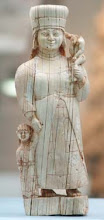
In ancient ages, when the life was primitive but mankind had started to think what all these were around, who they were, and answers to similar questions, let us imagine a man to predict its dominant life synergy and intellectual activities. First of all, they had totally different modes sensually during day and night. Day, their sight ability was comparably perfect with respect to night, thus they controlled easily the territory they lived. Night was potential danger, as the sense ability of man was not as developed as many dangerous animals might have. Their night activities were limited in a controlled space, first in caves later in houses. Main activities of the day, hunting and collecting were not easy in night. Thus, resting and house activities were organized for night. Day was more than enough for daily works.
During the day, they were under the light of sun. Sun was giving life to every thing in nature. What was sun? Even they could not look at the sun, they could not see it. It was the greatest power. They feared it and had worshiped it. They were on the earth. Similarly, they were far away from understanding what the earth was. In different regions of the earth, more or less, different communities were similarly in the same struggling. They were observing the same sun and standing on the same earth. We can say that main unknowns driving man to think were identical to all of them.
Total thinking time is one of the parameters in finding the answers in societies. In ancient time, as the main activities were hunting and collecting, any community that managed the main activities in shorter times had spared their times to think and discuss. When they settled leaving the nomadic life, they gained more power to understand the events, yet the main unknowns were still to be understood. The different regions of the earth gave different degree of advantages to them, to achieve more in their daily life and prosperity subsequent to this achievement. Life style and beliefs were different then when they started to live in antique ages. Nile valley, Mesopotamia, and Asia Minor were more prosperous regions when the societies had started to settled life. As a result of this, the men lived in these regions were lucky than the others, thus they reached more reasonable answers to the unknowns of the past before the others did.
As the different communities had created their own beliefs, were there interactions among them? I believe there was. In addition to wars and invasions, trading were the main channels of interactions. Invaded cultures were under influence of the invaders. If invasion was long lasted and injuries were forgotten, then cultural interaction was unavoidable. Trading was also a powerful way of interaction as it was peaceful and joyful. Let us imagine again, a world that no powerful communication was possible. The traders were availing the news from the other communities and countries as they were selling their goods. To be interesting, I believe the antique time traders were exaggerating the news to level of story, thus more success in their business since story telling was a kind of attraction for the local public. New deities, kings, queens, power of them, new arms, all were in the stories. The public had spread such information quickly among the individuals by their auricular tradition; in each step the stories had been changed.
A typical example for cultural interaction in antique time is Chimera Myth that we trace in different cultures as variances. I preferred this example as Chimera is characterized to Lycia, my favorite. Chimera is a beast of mixture of three animals: lion, goat, and serpent in Greek mythology, where this myth had been adopted from Lycians, I believe, similar to importation of main deities of ancient Greek from Lycia (then Lukka). The interaction of Greek and Lukka cultures in this example is not a complete adaptation of the myth, but a composition of different aspects from both cultures. In the myth, the Chimera was slain by Bellerophon who was Greek originated. The location of the myth, however, was Lycia. Then we need to ask what the origin of it was. Indeed, at the same times, the Hittites had a myth similar to Chimera, Illuyanka. In Sumerian history we observe it as variant, Asag and Ninurta.
One of the antique Greek myths is Lamia who was a serpent. In Greek mythology, Typhon who was slain by Zeus was the father of Chimera. No need to say it is too complicated. If we continue with more comprehensive stories, we need to mention about Shahmeran, which is perceptibly a Persian version of Chimera, meaning queen of serpents. Lycia was occupied by Persians for a long time during which Lycia adopted Persian clothing into their daily life. In one of the Roman ground mosaics found in Palymyra in Syria, Bellerophone is depicted with Persian cloths. Besides, Chimera and Shahmeran are phonetically similar. Then, who originated this Chimera myth? Sumerians, Assyrians, Hittites, Lycians, or Persians? Or Greeks, although unlikely?
I suggest the originator was Sumerians with Asag. All others are the variants of it. As Sumerians had a considerable influence on today’s major religions, more recent stories like 1001 Nights had religious traces in them. Regarding the name Chimera, the origin is Persian since Shahmeran has a meaning in Persian language, king of serpents, which was believed to live under ground, with flames from its mouth. That is why Chimera was believed by Lycians to live in depths of Olympos, today’s Cirali in Turkey, where natural gas flames still fire.
Ali Citci - August 2007
During the day, they were under the light of sun. Sun was giving life to every thing in nature. What was sun? Even they could not look at the sun, they could not see it. It was the greatest power. They feared it and had worshiped it. They were on the earth. Similarly, they were far away from understanding what the earth was. In different regions of the earth, more or less, different communities were similarly in the same struggling. They were observing the same sun and standing on the same earth. We can say that main unknowns driving man to think were identical to all of them.
Total thinking time is one of the parameters in finding the answers in societies. In ancient time, as the main activities were hunting and collecting, any community that managed the main activities in shorter times had spared their times to think and discuss. When they settled leaving the nomadic life, they gained more power to understand the events, yet the main unknowns were still to be understood. The different regions of the earth gave different degree of advantages to them, to achieve more in their daily life and prosperity subsequent to this achievement. Life style and beliefs were different then when they started to live in antique ages. Nile valley, Mesopotamia, and Asia Minor were more prosperous regions when the societies had started to settled life. As a result of this, the men lived in these regions were lucky than the others, thus they reached more reasonable answers to the unknowns of the past before the others did.
As the different communities had created their own beliefs, were there interactions among them? I believe there was. In addition to wars and invasions, trading were the main channels of interactions. Invaded cultures were under influence of the invaders. If invasion was long lasted and injuries were forgotten, then cultural interaction was unavoidable. Trading was also a powerful way of interaction as it was peaceful and joyful. Let us imagine again, a world that no powerful communication was possible. The traders were availing the news from the other communities and countries as they were selling their goods. To be interesting, I believe the antique time traders were exaggerating the news to level of story, thus more success in their business since story telling was a kind of attraction for the local public. New deities, kings, queens, power of them, new arms, all were in the stories. The public had spread such information quickly among the individuals by their auricular tradition; in each step the stories had been changed.
A typical example for cultural interaction in antique time is Chimera Myth that we trace in different cultures as variances. I preferred this example as Chimera is characterized to Lycia, my favorite. Chimera is a beast of mixture of three animals: lion, goat, and serpent in Greek mythology, where this myth had been adopted from Lycians, I believe, similar to importation of main deities of ancient Greek from Lycia (then Lukka). The interaction of Greek and Lukka cultures in this example is not a complete adaptation of the myth, but a composition of different aspects from both cultures. In the myth, the Chimera was slain by Bellerophon who was Greek originated. The location of the myth, however, was Lycia. Then we need to ask what the origin of it was. Indeed, at the same times, the Hittites had a myth similar to Chimera, Illuyanka. In Sumerian history we observe it as variant, Asag and Ninurta.

One of the antique Greek myths is Lamia who was a serpent. In Greek mythology, Typhon who was slain by Zeus was the father of Chimera. No need to say it is too complicated. If we continue with more comprehensive stories, we need to mention about Shahmeran, which is perceptibly a Persian version of Chimera, meaning queen of serpents. Lycia was occupied by Persians for a long time during which Lycia adopted Persian clothing into their daily life. In one of the Roman ground mosaics found in Palymyra in Syria, Bellerophone is depicted with Persian cloths. Besides, Chimera and Shahmeran are phonetically similar. Then, who originated this Chimera myth? Sumerians, Assyrians, Hittites, Lycians, or Persians? Or Greeks, although unlikely?
I suggest the originator was Sumerians with Asag. All others are the variants of it. As Sumerians had a considerable influence on today’s major religions, more recent stories like 1001 Nights had religious traces in them. Regarding the name Chimera, the origin is Persian since Shahmeran has a meaning in Persian language, king of serpents, which was believed to live under ground, with flames from its mouth. That is why Chimera was believed by Lycians to live in depths of Olympos, today’s Cirali in Turkey, where natural gas flames still fire.
Ali Citci - August 2007















